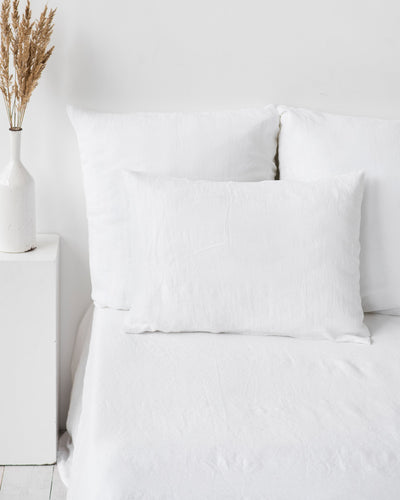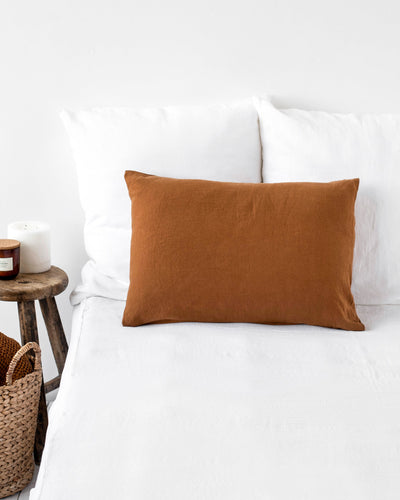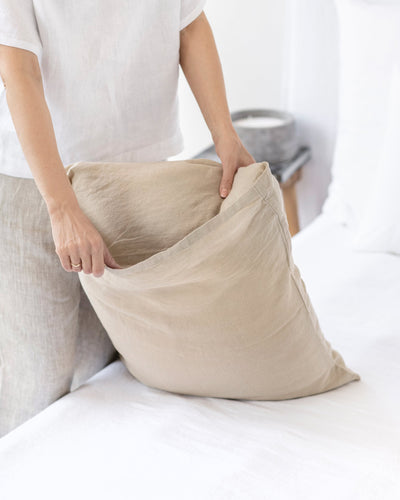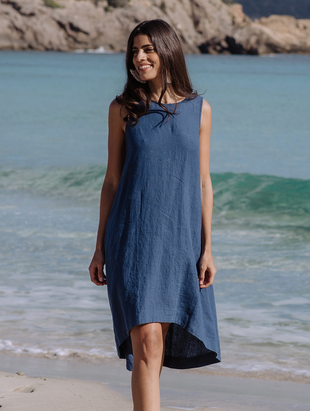Linen vs. Cotton Shirts: A Guide to Comparing Summer Wear

As summer approaches and temperatures rise, choosing the right fabric for your wardrobe becomes essential for staying cool and comfortable. Among the pool of fabric choices available, linen and cotton shirts stand out as popular options for warm weather. But which one is better suited for your summer needs?
In this guide, we'll compare linen vs. cotton shirts in detail, exploring their benefits, drawbacks, and key differences between linen and cotton as fabrics. Join us to find out which fabric is the best fit for your summer wardrobe.
Benefits of Linen vs. Cotton Shirt
 Both linen and cotton shirts have unique advantages for summer wear. Let's explore the key benefits of each.
Both linen and cotton shirts have unique advantages for summer wear. Let's explore the key benefits of each.
Linen shirts
The main properties that make linen shirts superior for summer wear include the following:
Breathability
One of the standout features of linen is its breathability. Linen fibers are loosely woven, allowing for excellent airflow. This means that when you wear a linen shirt, more air circulates around your body, keeping your skin well-ventilated and cool. On those scorching summer days, a linen shirt can make a significant difference in how comfortable you feel, preventing the sticky, sweaty sensation that often accompanies high temperatures.
Moisture-wicking
Linen also excels in moisture management. Its fibers can absorb up to 20% of their weight in moisture without feeling damp to the touch. This capability means that sweat is quickly drawn away from your skin and released into the air, promoting rapid evaporation. In hot and humid conditions, this property keeps you dry and comfortable, reducing the risk of skin irritation and discomfort.
Durability
Despite its lightweight feel, linen is one of the strongest natural fibers and can withstand a lot of wear and tear. Linen shirts can withstand significant wear and tear, often outlasting other fabrics, making it a long-term investment for your wardrobe.
Eco-friendly
Linen remains superior in sustainability compared to many other fabrics. It takes only 6.4 liters of water to make a linen shirt. Additionally, flax plants don't require pesticides and can grow even in poor soil conditions. Moreover, linen is biodegradable and recyclable, making it a more environmentally friendly choice if you're concerned about your ecological footprint.
Cotton shirts
Now, let's explore some of the key benefits that make cotton shirts a popular choice.
Softness
Cotton is renowned for its soft, smooth texture. When you wear a cotton shirt, you'll immediately notice how gentle and comfortable it feels against your skin. This softness makes cotton ideal for casual and everyday wear.
Versatility
One of the greatest strengths of cotton shirts is their versatility. Cotton can be easily dressed up or down to suit various occasions. They also come in an array of colors, patterns, and styles, offering endless possibilities for creating different looks. This versatility ensures that your wardrobe remains adaptable and stylish, no matter the occasion.
Hypoallergenic
Cotton is a natural fiber known for being gentle on the skin. It is less likely to cause allergic reactions or skin irritation, making it an excellent choice for individuals with sensitive skin. So, cotton shirts provide a safe and comfortable option for everyone, reducing the risk of itchiness or discomfort that can sometimes accompany synthetic fabrics.
Wide availability
Cotton is one of the most widely available fabrics globally. It's also available in various styles, colors, and price ranges. This accessibility ensures that you can always find a cotton shirt that meets your preferences and fits your budget, making it a practical and convenient choice for many.
Drawbacks of Linen vs. Cotton Shirt

While both linen and cotton shirts have advantages, they also have potential drawbacks. Here are some of them.
Linen shirts
Linen shirts are a wardrobe staple, but they come with certain limitations that you should be aware of, such as:
Wrinkling
Linen fibers are inherently strong and durable; however, they lack the elasticity found in other fabrics like cotton. This means linen shirts tend to wrinkle easily, giving them a more casual, lived-in look. For those who prefer a crisp, polished appearance, maintaining a linen shirt can be challenging. Frequent ironing or steaming is often necessary to keep the shirt looking neat, which can be both time-consuming and inconvenient, especially for individuals with busy lifestyles.
Texture
While linen gets softer with each wash, it initially has a coarse and rougher texture. The rougher feel is due to the fabric's loose weave. This initial roughness can deter some people from choosing linen, especially if they are accustomed to the immediate softness of materials like cotton or synthetic blends.
Cost
Linen is generally more expensive than other fabrics like cotton or synthetics. The higher price point is attributed to the labor-intensive production process, which includes steps like retting, scutching, and weaving, and the relatively lower yield of flax plants compared to cotton.
Cotton shirts
Despite their widespread popularity, cotton shirts also come with certain disadvantages that are worth considering. They include:
Durability
While cotton is a durable fabric, it's not among the most durable. Cotton shirts, especially those made from lower-quality cotton, tend to wear out over time. Frequent washing, exposure to harsh detergents, and high-heat drying can accelerate this wear and tear, causing the fabric to weaken and develop holes. Even high-quality cotton can show signs of aging, such as thinning fabric and fading colors, after repeated use and laundering.
Shrinkage
Cotton shirts are prone to shrinkage when exposed to high temperatures during washing and drying. To avoid this, cotton shirts often need to be washed in cold water and air-dried or tumble-dried in a low-heat setting, which may not always be convenient for everyone.
Environmental impact
The cultivation of cotton plants requires a significant amount of water. It can take up to 2,700 liters of water to produce a single cotton shirt. Cotton plants also often require a heavy use of pesticides and fertilizers. This high environmental footprint can be a concern for environmentally conscious consumers looking to minimize their ecological impact.
Key Differences Between Linen vs. Cotton Shirt
Knowing the differences between linen and cotton shirts can help you select the fabric that best meets your comfort and style needs. So, here are the key differences between linen and cotton shirts.
Fiber source
One of the main differences between linen and cotton shirts is the kind of fibers that make up their fabrics. Linen is made from the fibers of the stem of the flax plant (Linum usitatissimum).
Cotton, on the other hand, derives from the fibers surrounding the seeds of the cotton plant (genus: Gossypium).
Cotton's production process is more streamlined and efficient, which helps keep costs lower and makes it widely available. Meanwhile, the production of linen is more labor-intensive and time-consuming, contributing to its higher cost and unique texture.
Texture

Linen and cotton shirts also differ in feel. Linen has a coarser, more textured feel due to the thickness and length of the flax fibers. This texture can feel rougher to the touch but becomes softer with each wash. Conversely, while cotton may initially be softer and smoother, it is prone to pilling and damage over time.
Care and maintenance
Both fabrics are relatively easy to care for, but linen requires more effort to maintain its pristine condition. Linen shirts tend to wrinkle easily, especially if not dried properly. To keep linen shirts looking their best, they often need to be air-dried and ironed while still slightly damp.
Cotton shirts are generally lower maintenance. They can be machine-washed and dried without much fuss, although care should be taken to avoid high temperatures that can cause shrinkage. Cotton is also more resistant to wrinkles, making it easier to keep looking neat with minimal effort.
Climate suitability
Both linen and cotton shirts are versatile for various climates. However, linen shirts are ideal for hot and humid climates due to their breathability and moisture-wicking properties. Cotton shirts are also adaptable to multiple climates. They're breathable for warm weather, and heavier cotton shirts can provide warmth in cooler climates.
Longevity
While both linen and cotton shirts can last you for many years, linen shirts tend to last longer when properly cared for. On the other hand, cotton shirts are more prone to pilling and wear over time, especially with frequent washing and drying.
Choosing Between Linen and Cotton for Summer Wear
When deciding between linen and cotton for summer wear, you should consider factors like personal preferences, lifestyle, and climate.
If you prefer a fabric that feels cool and crips, linen is an excellent choice, whereas if you prioritize softness and a gentle feel against the skin, cotton is more suitable. Additionally, linen offers a relaxed and effortlessly chic look, whereas cotton comes in various styles, from casual to formal.
You should also consider whether your lifestyle allows you to care for them properly. As linen requires extra care, it may not be ideal for those with busy schedules who don't have time for frequent ironing or special washing routines. Cotton, being more low-maintenance, is suitable for a fast-paced lifestyle.
Lastly, if you live in a warmer and humid climate, linen is ideal to keep you cool and comfortable, whereas cotton may not wick away moisture as effectively as linen.
The Bottom Line
As linen and cotton shirts offer distinct benefits, it can be challenging to choose between them. When choosing, it's crucial to consider factors such as breathability, texture, durability, and environmental impact. Ultimately, the best choice depends on your preferences and lifestyle. So, weigh the pros and cons of each fabric to find the balance of comfort and style for your summer attire. Whether you prioritize the crisp, airy feel of linen or the soft nature of cotton, making an informed decision will ensure you take summer by storm.
Frequently Asked Questions (FAQs)
Are linen and cotton shirts suitable for summer wear?
Yes, both linen and cotton shirts are excellent choices for summer wear. They're lightweight, breathable fabrics that help you keep cool and comfortable in hot weather.
Can linen shirts be worn casually and formally?
Linen shirts are versatile and can be dressed up or down depending on how you style them. For a more casual look, you can pair a linen shirt with shorts and sandals or sneakers. On the other hand, for a more formal occasion, you can wear a linen shirt with trousers and dress shoes and layer it under a blazer.
Can linen and cotton shirts be layered with other clothing items?
Linen and cotton shirts can easily be layered with other clothing items, transforming your outfits into a clean, crisp look.
 United States
United States













